The concept behind Formula Student is that a fictitious company hires a team of engineers to develop a formula-style racing car for non-professional drivers who would participate in single-make races. Each team of students designs and builds the prototype within the rules of the competition, which has two main objectives: to encourage creative solutions and to ensure safety on the track, as the single-seaters are driven by the students themselves.
In each competition all the prototypes are evaluated by the judges of "the company" (experts in the motor world) through different tests to decide which is the best proposal as a project and to produce it in series. In total there are 1,000 points that are distributed as follows (there may be variations depending on each competition):
| Static tests | Points | Dynamic tests | Points |
|---|---|---|---|
| Design Event | 150 | Acceleration Event | 75 |
| Cost & Manufacturing Analisys Event | 100 | Skidpad Event | 50 |
| Presentation Event | 75 | Autocross Event | 150 |
| Endurance Event | 300 | ||
| Fuel Economy | 100 |
There are two types of tests depending on the condition of the car: on the one hand there are static tests, which do not require the car to be in motion, and on the other hand there are dynamic tests, in which points are awarded according to the time achieved. Each of these scoring tests will be explained below, starting with the static tests:
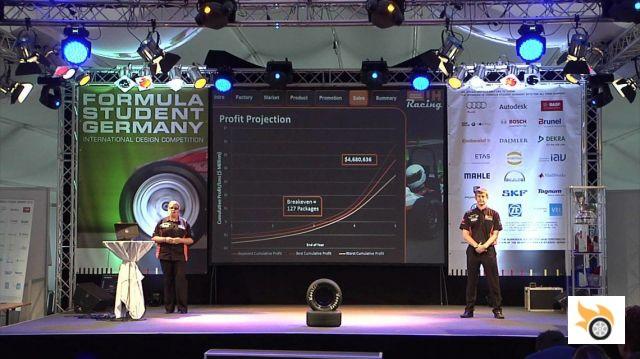
Static tests
- Design Event: A team of judges, experts in different automotive fields, evaluate the overall design of the single-seater, the criteria used to make the decisions and the knowledge of the people in charge of each section. At the end of the test, the head judge addresses the team to give them his impressions, so that the following year the teams know what their strengths are and what aspects of the car need to be improved.
- Cost & Manufacturing Analysis Event: Weeks before the competition, the team must present a very complete document, where the manufacturing costs of each and every part of the single-seater are accounted for. To do this, the organization provides the students with standard cost tables detailing the costs of materials (kg of raw materials, m² of composite fabric...), processes (machining, injection, casting, assembly...), moulds, tools, screws and standard commercial elements such as tyres or shock absorbers. From these tables that simulate the costs for the manufacture of 1,000 vehicles; the teams detail everything. A team of judges evaluates the correctness of the document by comparing it with the real car.
- Presentation Event: One or more team members present a "Business Plan" as a presentation to the judges. In it they argue and defend why it is in the company's interest to go for the mass production of their single-seater and not that of other teams. They can use all kinds of commercial and technical arguments such as the high performance, explaining how they will organize competitions with the single-seaters as a single-brand cup, the profitability of mass production, the organization of special events, etc.
Technical inspections
One of the main pillars of Formula Student is safety, that's why before performing the scoring dynamic tests, the single-seater is subjected to four mandatory technical inspections that do not score points. In these inspections it is checked that the design of the car has the necessary safety measures to compete. If the car does not pass the inspections it will not be able to compete in the dynamic tests. These four technical inspections are:
- Scrutineering: A team of experts in the automotive world evaluate that the single-seater meets all the necessary technical requirements specified in the competition regulations. They check in detail distances, geometries, the driver's position, chassis safety arches, vehicle weight, materials, solutions used... Finally a test is carried out in which the driver has to be able to get out of the car in less than five seconds.
- Tilt Test: the single-seater with the driver is placed on a horizontal platform. This is initially tilted at 45 degrees to check that there is no loss of fluids, and then tilted up to 60 degrees to check that it does not tip over, demonstrating its stability against lateral forces.
- Noise Test: single seaters with a combustion engine must rev the engine up to a specified speed according to the regulations depending on the type of engine. The noise level measured at a specific distance from the exhaust pipe may not exceed 110 dBa.
- Brake Test: the driver must accelerate during a specific section and be able to brake by locking all four wheels at the same time, without deviating its trajectory, thus demonstrating that the single-seater has sufficient braking capacity and a minimum level of stability when doing so.
- Rain Test: the electric single-seaters must pass a test where the car is sprayed with water to verify the correct insulation of all the electrical components.
Once each of the inspections is completed, the corresponding official will place a sticker on the car. Only cars with all four stickers will be allowed to perform the dynamic tests.
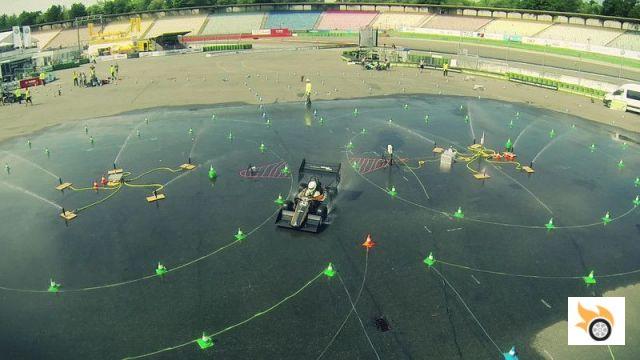
Dynamic tests
In the dynamic tests, points are awarded according to the time achieved (except in the "Fuel Economy"), the first classified gets the maximum points of the test, and the points of the others are calculated by formulas according to the time of the first classified. To mitigate the advantage of a team with a very skilled driver, drivers are only allowed to take part in two of the five events, so the results will better represent the actual performance of the car.
- Acceleration Event: In this test the time it takes the car to cover 75 meters accelerating from a standstill is timed. Four attempts are made, two per driver.
- Skidpad Event: In a circuit in the shape of an eight, delimited by cones, the time needed to complete the two circles of the "eight" in one direction and the two circles in the opposite direction at the maximum possible speed without touching the cones is timed. In this way the stability and cornering of the single seaters is evaluated. Four attempts are made, two per driver.
- Autocross Event: On a circuit of about 800 meters, very twisty, two laps are made in a row at maximum speed. Four attempts are made, two per driver.
- Endurance Event: On a circuit larger than the previous one, an endurance test will be carried out, with laps to complete a total of 22 kilometres. A compulsory stop is made after 11 kilometres to change drivers, switching off the engine and restarting it, testing the reliability of the car to the limit, this is the last race of the competition and the one that usually determines the winning team. It is also the only race in which there is more than one car on the track at the same time, with overtaking taking place using blue flags in various areas marked out for this purpose. For these reasons it is the test that generates more expectation.
- Fuel Economy: It measures the energy needed by the single-seater to complete the 22 kilometers during the endurance test, either in gasoline, ethanol or extracted from the batteries. In order to score points in this test it is necessary to have completed at least the first half, and that the team's time does not exceed the fastest by a certain percentage; to avoid driving too slowly. The score is calculated as a combined factor between time and energy consumption.
The competition
The competitions take place over several days at international racing circuits such as Hockenheim (Germany), Silverstone (UK), Montmeló (Spain), Varano (Italy), A1 ring (Austria)...
In Europe the most important events are the UK and German races. The UK was the first competition organized in Europe, in 1998, it is logical considering the great tradition of the country in the automotive world. Germany was launched in 2006 and is currently considered the highest level competition in the world, as well as the most popular and the best organized. More than 130 teams from universities all over the world, from more than 30 different countries from all continents take part in it. It would undoubtedly have a higher participation, but registrations are limited. Teams must answer an online quiz against the clock, with questions about the rules of the competition; the first to answer all questions correctly will be awarded a place.
The competition is currently divided into two categories according to the type of engine: combustion or electric; and there are also two sub-categories: "Class 1" and "Class 2". Class 2 is for new teams that have just started, do not have a built car and only participate in the static tests to test their project. Class 1" is the main class, where teams compete with their finished cars in the dynamic tests. An important feature of the competition is that the chassis of the car must be a new design every year, thus encouraging innovation from the teams.
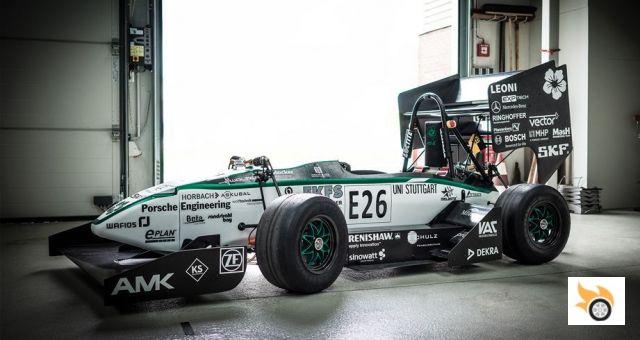
The average team, consisting of about 20-30 students, participates in two or three competitions a year, which take place in the summer months. The competition schedules depend on various aspects such as the number of participating teams, the size of the organisation, etc. However, they usually follow the same pattern. One or two days are scheduled for the teams to arrive at the facilities and prepare for the competition. On the following two days, the static tests and technical inspections are carried out to allow them to participate in the dynamic tests. On the last two days, the dynamic tests are competed in.
All this is done following strict schedules set by the organization.
The competition is based on safety, based on strict regulations, so it is forbidden to start the engine in all the enclosure with the exception of a test area and in the dynamic test areas. To reduce the risk of accidents, speeds are restricted by means of short, twisty circuits, with ample space for possible escapes. The acceleration test takes place on the main straight of the professional circuit, as does much of the endurance test. As several teams race at the same time, if a slower car is slowing down a faster one, the judges signal the overtaking with blue flags and the slower car must swerve into a designated area to give way and be safely overtaken. It must be taken into account that the drivers are students, not professionals; although the driving level in many teams is very high.
There is a world ranking that is updated after each competition. This ranking is calculated by mathematical formulas according to the points obtained in the last six competitions in which each team has participated, these points are weighted according to the "importance" of each competition; increasing even more the competitiveness between the teams.
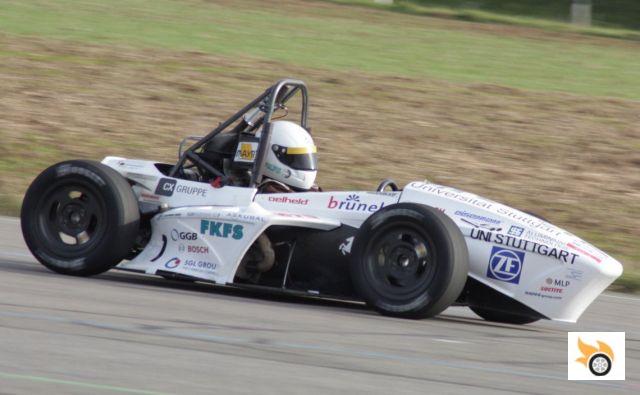
Technical evolution
In contrast to the restrictive safety regulations, most of the components have very lax regulations that allow for a wide variety of technical solutions. In recent years the average Formula Student car has undergone a spectacular technical evolution, let's take a look at a comparison between the cars of the competitive University of Stuttgart team from 2008 and 2015:
| 2008 season | 2015 season |
|---|---|
| Total weight: 210 kg (without driver) | Total weight: 170 kg (without driver) |
| 0-100 km/h in 3.7 s | 0-100 km/h in less than 2 s |
| Top speed 123 km/h (limited by gear ratio) | Top speed 130 km/h |
| Tubular steel chassis with carbon fibre body panels | Carbon fibre monocoque chassis with 6.8 kWh in-floor batteries |
| 13″ steel wheels | 10″ aluminum and carbon fiber hybrid wheels. |
| Motorcycle engine: Honda CBR 600RR (intake bore is limited and engine ECU injection and ignition must be re-mapped) 94 hp and 64 Nm. | All-wheel-drive system with four electric motors at the wheels, allowing torque-vectoring and energy recovery, 128 kW / 171 hp and 1,200 Nm |
| Without aerodynamic package | Complete aerodynamic package: front and rear spoiler, flat bottom with diffuser |
Extreme weight reduction thanks to carbon monocoque, seat and rims; all-wheel drive systems, with torque-vectoring, hybridization, energy recovery, telemetry, complex aerodynamic solutions... In 2017 the Formula Student competition in Germany will introduce for the first time a new third category: the autonomous car. Not too many details are known at the moment, except that the car will have to drive an autonomously guided cone-shaped course.
As can be seen, the competition has reached a very high level of competitiveness and technical demand. This means that Formula Student provides students with real experience in design and construction; negotiations with the automotive industry in search of suppliers; teaches students to work in a team, under pressure and with strict deadlines; making it one of the most important platforms for the promotion and learning of future professionals in the automotive world.
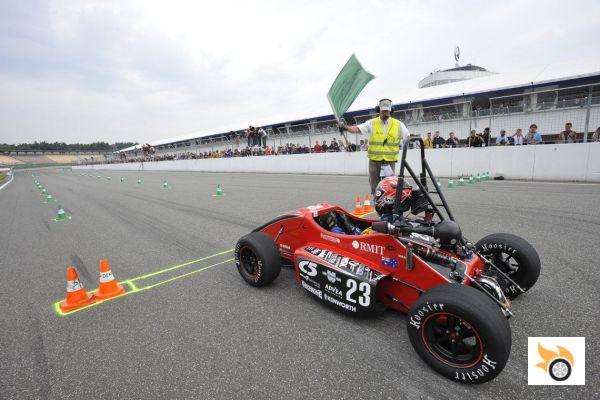
The organization of the team
From the point of view of a student who starts in a team, a good way to start the season is to go to the competition in his country as an assistant, without participating in the work of the team (as he is not registered for that year); to see how the tests are, how the team works and thus understand its operation and organization. At the beginning of the course it is decided which students will be the leaders of the team, normally veteran students in the team; and it is organized which students will participate in each section according to their knowledge and aptitudes.
The sections can be: Packaging, Chassis-Monocoque, Engine-Powertrain, Shifting, Electronics, Pedals, Ergonomics, Aerodynamics, Management....
Important architectural decisions are usually made in September and October, which is usually determined by the confirmations of the main sponsors. The mechanical design is closed around December or January, as this is required by the competition as a lot of data about the car must be sent, and be accepted in order to be able to participate. The car is usually finished between the last days of June and mid-July, depending on the deadlines of the competitions in which they participate, in order to have a few weeks to test and adjust the car and for the drivers to adapt to driving it.
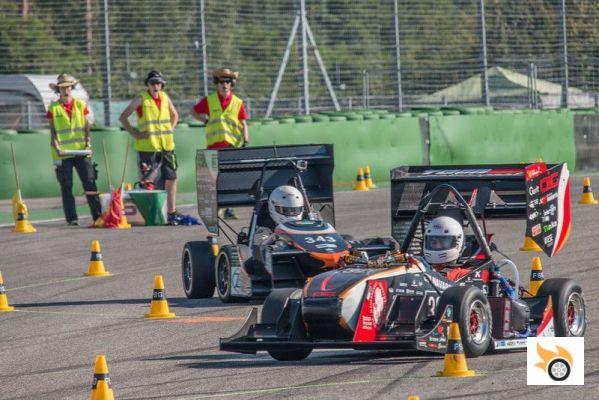
How is all this paid for?
The main source of funding for the newly founded teams comes from the public sector, and especially from the university. A first basic and not inconsiderable contribution is the cession of the always reduced space in the faculty. In order for a team of at least 25 people to be able to work on a project with such tight deadlines, it is necessary to have a space in which to hold meetings, discuss and debate aspects of the project, etc. In addition to the office, it is also necessary to have a suitable mechanical workshop in which to store the parts as they are manufactured or purchased, where they can be worked on, assembled and adjusted on the vehicle, etc.
In order to reduce project costs and manufacturing times, it is necessary for students to be able to use the machinery of the various departments of the university: lathes, milling machines, analysis equipment, test benches, etc. In this way, vehicle parts can be manufactured at the university itself and only the raw materials need to be purchased.
The third way for a university to collaborate in the project is to contribute cash. This is necessary to pay for the inscription in the competitions: about 500 euros per team of 20 students depending on the competition; to buy raw material, to buy commercial components; and the team's travel expenses: to move 20 people and a single-seater, plus the tools, spare parts, tents, etc.
Beyond the university, it is common to receive sponsorship in the form of a grant from a public body. In the end, these are key projects for the region, as they represent a link between companies and the university for the development of new products and technologies. Under the umbrella of Formula Student, new internal combustion engines or algorithms for the control of electric vehicles have been developed, to give just a few examples. This has been achieved at the highest technological level, as evidenced by the fact that almost annually a Formula Student team breaks a new Guinness record (usually for acceleration with an electric car).
On the other hand there is the funding through private sector investment; as the project grows and consolidates, over the years so does its presence in the media. This makes the participation of private companies in the project a very attractive option because of the return received. Companies can contribute in different ways depending on their profile. The simplest and most difficult to achieve is a pure economic contribution to the project. Normally a company is reluctant to contribute cash, as it is more difficult for it to obtain a return.
Much more common is a contribution in kind. For example, if a company is involved in the manufacture of carbon fibre components, it is relatively easy for it to give its facilities to the team for the manufacture of the monocoque. The cost is relatively low and the value of the contribution is very high. This approach offers the greatest potential return for the company. For example, a company runs its own vocational training centre and as part of this training, its students in the machining module are responsible for manufacturing parts designed by the Formula Student teams.
In this way the benefit is absolute on both sides: the students of the module can manufacture parts with real utility that the others have designed, and the teams get parts at a lower cost. Another case would be that of a company dedicated to the design of electrical systems and has collaborated with a team in the development of the wiring and electronics of the vehicle, doing so will have contributed to train students in these subjects. If the company has a vacancy to fill, they will have contact with students who have recently graduated but who will already have had experience in the design of these components and will also know the environment of the company in question. This is the real value that can be obtained by the companies that contribute to the projects.
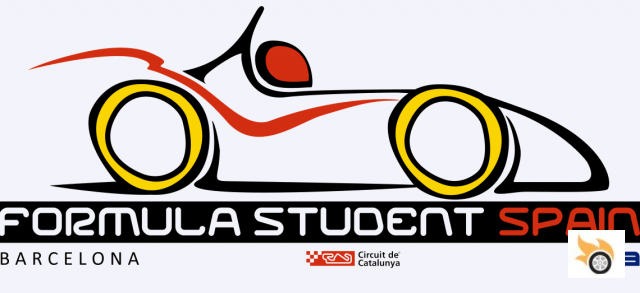
The final value of a project is a subject that is always the subject of debate, since depending on how the valuation is made, very different figures can be obtained. The most humble projects can be completed with relatively little money. You need a motorcycle engine that can be second hand and, to simplify, raw material to manufacture all the components. With little more than 5,000 euros in cash you can have everything and pay an entry fee for a local competition, with some of the students travelling.
At the other extreme, especially in the electric vehicle category, the battery pack alone can cost up to 20,000 euros. If all the financial and in-kind contributions from sponsors and universities are taken into account, a project can quickly reach 250,000 euros.
Finally, a third contribution can be added, although it is more of a personal opportunity cost for the students. A student dedicates approximately 1,000 hours to the project and this usually means that they have to extend their studies by a year or more. On a personal level, this means giving up a year's salary. If you consider the hours of work invested by the students is when you really appreciate the value of the project and the work behind it.
Formula Student in Spain
The first participation of a Spanish team in Formula Student was the Universidad Politécnica de Madrid in 2002; year after year new teams have emerged until the more than 20 we have today. The results of the Spanish teams are still far from the top positions, although there is a great progression. Currently the world ranking of the electric category has three Spanish universities in the top 50.
The only competition held in Spain, called Formula Student Spain, is at the Montmeló circuit. The first edition was in 2010 and a total of 11 teams participated, including five German and four Spanish. It is worth noting the consolidation that has had this competition because this year (2016) participation has soared to 70 teams.
I hope you have been interested in Formula Student, and I would like to take the opportunity to invite you to go to Montmeló next year to see first hand this very interesting competition.

























